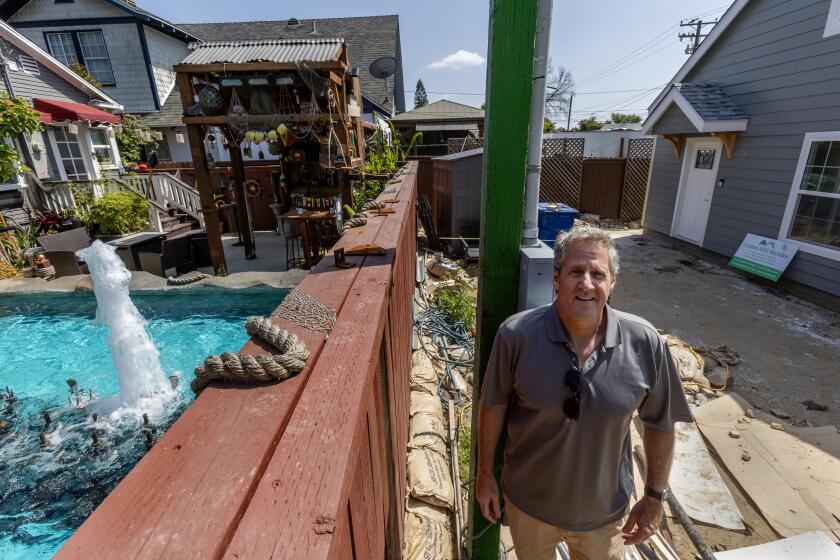Counties diverge on plan to widen the 405 : O.C. wants more lanes, but L.A. County won’t go down that road.
Orange County’s plan to widen a traffic-clogged stretch of the 405 Freeway is facing unexpected opposition from some residents along the route and has generated new debate over the divergent transportation priorities of L.A. and Orange counties.
The plan targets one of the region’s biggest traffic trouble spots, where 300,000 cars travel each day between Irvine and the L.A. County border. Without the improvement, Orange County transportation officials said maximum commute times during peak hours will continue to increase.
But critics say the project is a prime example of a lack of regional coordination between Orange and Los Angeles counties. L.A. County officials have no plans to widen their portion of the 405 beyond the county line, and some worry about creating a bottleneck near where the 405, 605 and 22 freeways merge.
Such a bottleneck developed a few years ago, when Orange County widened the 5 Freeway through Buena Park and L.A. County didn’t follow suit. Now, traffic regularly backs up at the county line.
The situation underscores a basic philosophical difference between the counties. L.A. has focused its transportation money on opening new rail lines: the Gold Line Eastside extension, which opened over the weekend, and the Expo Line from downtown to Culver City, which is under construction. Orange County doesn’t have light rail and has focused its resources largely on improving freeways and surface streets.
“L.A. is more transit-oriented; Orange County is more freeway-oriented,” said Peter Buffa, chairman of the Orange County Transportation Authority. But as congestion mounts, that attitude will probably change, he believes.
“Ultimately, because of the pressure -- with the growing population, environmental impacts -- ultimately people will say, ‘We get it, we can’t get around one person to a car, that’s not going to work.’ In Orange County, quite frankly, we’re not there yet,” he said.
Buffa said many of the major differences in the transportation approaches are because of the counties’ differing populations. Rail customers in Orange County usually have cars and take the train to avoid congestion or to save money on gas. In Los Angeles County, however, there are more people without cars who must rely on the bus or rails.
L.A. County has “more people, but also denser areas where trying to sell a rail line that goes down the middle of the street is a little easier than in some kind of wide open, very suburban, south Orange County city. . . . It’s a political fight,” Buffa said.
The disputes surrounding the plan to widen the 405 could be the first signs of the sort of political change that Buffa forecasts.
One hotbed of opposition to the widening is Westminster, a suburb of 90,000 that straddles both the 405 and 22 freeways. There, critics have been fighting over the 405 widening for years, saying OCTA could better spend the money on other transportation needs like street improvement, more buses and perhaps even a rail system.
“They’re adding two lanes and putting everyone through this, and then they’ll turn around and 10 years from now, we’ve got to expand four more lanes,” said Paul Martorella, 51, a Westminster resident. “It’s impractical to keep pouring cement.”
In the last two decades, various Orange County entities have opened toll lanes on the 91 Freeway, built three toll roads and added miles of carpool lanes. The 405 is just the latest major project.
Up to two lanes would be added on each side of the roughly 14-mile stretch of the 405 between the 73 Freeway and the 605. Bridges would also be rebuilt, some homes would be taken under eminent domain and the carpool buffer would shrink.
“We’re not just talking about adding lanes to the 405, we’re talking about improving . . . ramps and connectors to the local streets,” said Rose Casey, project program manager for OCTA. “Communities will see a benefit to their local traffic circulation.”
OCTA says it’s taken steps to prevent the kind of bottleneck that exists on the 5. For example, the project would branch off four lanes for vehicles moving from the 405 to the 605 and 22. Officials say this design would improve traffic flow at the busy junction and smooth out traffic flow for commuters going between L.A. and Orange counties on the 405. They believe this design will prevent bottlenecks even if L.A. County does not widen its side of the 405, which it is unlikely to do soon.
OCTA first approached residents in 2005 with an array of possible options to reduce congestion. Among them was adding a rail line, but the agency found it too expensive. At first, the widening called for the removal of 100 homes; later plans reduced that number to 11.
The reduction seemed to satisfy some residents. Then in January, officials said lower-than-expected tax revenue and rising construction costs had forced them to make changes in the plan.
One idea has been particularly controversial: adding a regular lane and creating a two-lane “expressway” for carpoolers and drivers willing to pay a toll.
OCTA officials said revenue from the expressway would help pay for the project and potentially other freeway improvements.
“They’d better drop it, or fix it right,” said Westminster Mayor Margie Rice. “Because we’re not going to back off.”
OCTA officials maintain that the 405 widening will be welcomed by commuters and plan to move forward.
And L.A. County officials have no immediate plans to widen their segment of the 405 in that area.
L.A. County Metropolitan Transportation Authority chief Art Leahy, who headed OCTA for eight years, said one reason is that the L.A. County side has less space for expansion than Orange County does.
Leahy said this type of opposition is what L.A. County has had to deal with for decades because of its relative higher density. “Increasingly, Orange County is beginning to move toward the same kind of community resistance that is in Los Angeles,” he said. “L.A. is about 30 or 40 years further along in the process of becoming a big city.”
He believes that eventually population growth will force Orange County to invest more heavily in alternative transportation methods.
“The fact is, the traffic conditions are far worse in Southern California than in any other part of the country,” Leahy said. “There’s no doubt we have more in common, more to work together on, than apart.”
--
More to Read
Start your day right
Sign up for Essential California for news, features and recommendations from the L.A. Times and beyond in your inbox six days a week.
You may occasionally receive promotional content from the Los Angeles Times.






